Peter Flood
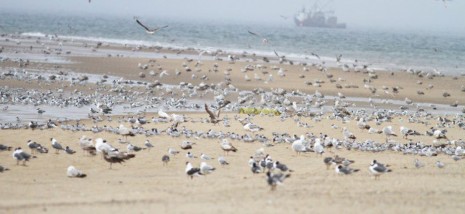
Gulls and terns, Race Point, May 10, 2015. All photographs by the author unless otherwise indicated.
Provincetown and the surrounding waters have a rich history of attracting exciting marine fauna including many species of seabirds, marine mammals, and sport fish. It can be argued that there is no better land-based vantage point along the Eastern Seaboard of the United States to view and appreciate the spectacular marine diversity found just offshore.
Strong tidal currents, deep offshore rips, and the proximity of the Stellwagen Bank National Marine Sanctuary to the north create dynamic oceanic conditions—mixing water masses and upwellings—that form the basis of a complex food web that attracts marine life. The abundance of sand lance (Ammodytes spp.) appears to be a significant driver in attracting seabirds and other marine fauna to the area. Two species of sand lance are likely at play off Provincetown, A. americanus, an inshore species, and A. dubius, an offshore species.
A banner year for seabirds off Provincetown, 2015 brought in thousands of seabirds of a variety of species during significant portions of the year. Seabirds from as far away as the eastern North Atlantic, the Arctic tundra, and islands off Antarctica arrived in and around Provincetown. A few mega-rarities also turned up and added additional sparkle to an already spectacular 2015 season. In many ways 2015 was a continuation and enhancement of a similarly extraordinary seabirding season off Provincetown in 2014. Given some of the recent mega-rarity sightings as well as late state records, the first few months of the 2016 seabirding season seem to be trending toward another spectacular year.
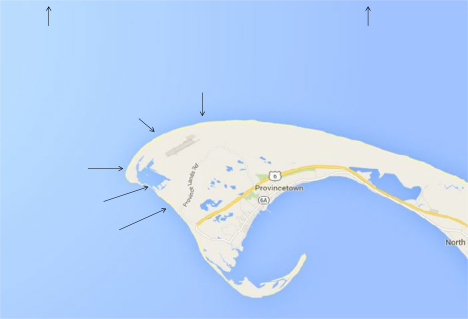
Fig. 1. Map of Provincetown.
For space constraints in summarizing and writing what could be a doctoral thesis, I have limited my discussion of seabirds to albatrosses, Northern Fulmars, petrels, shearwaters, storm-petrels, gannets, boobies, gulls, terns, jaegers, skuas, and alcids. However, I do mention a loon or two. Many observations and discussion points are based on personal experience and experiences of others. I gleaned and summarized seabird numbers and distributions from the eBird database.
I also have broken down the year by season, defining winter as January through March, spring as April through June, summer as July through September, and fall as October through December.
What are seabirds doing off Provincetown?
Watching seabirds regularly off Provincetown for the past 15–20 years has certainly sparked more questions than answers. Seabird movements and behavior can be unpredictable as well as interesting, but after studying seabirds over the years, I’ve been able to formulate several generalizations:
- The presence or absence of seabirds off Provincetown is food related
- Seabirds often stop feeding/moving at high tide
- A half tide falling is often preferred and potentially optimal for seabird feeding
- Seabirds are often moving in some direction at first light and early morning
However, I’m often puzzled by the behavior and movements of seabirds, and once I think I might be on to understanding something, an exception probes the rule.
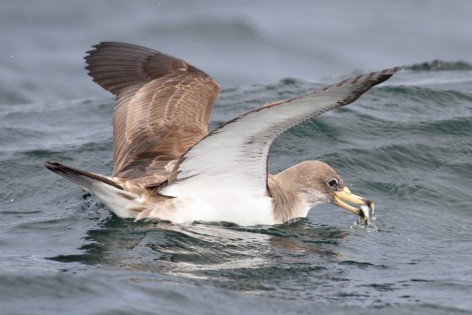
Fig. 2. Cory’s Shearwater with Sand Lance.
Food
How do seabird numbers correlate with sand lance populations? Do sand lance have population booms and crashes similar to lemmings on the arctic tundra? People forget that there also have been lean seabirding years off Provincetown.
Observations onshore and offshore from 2014 and 2015 indicate that the presence of sand lance appears to be a significant driving factor in attracting seabirds to the waters off Provincetown. Every year, I regularly watch gulls and terns feeding on sand lance and, at times, conspicuously carrying them in their bills. In 2015, I first witnessed shearwaters feeding on and carrying sand lance in their bills (Figure 2).
Tide and Timing
Why do seabirds generally stop moving or feeding at high tide? Does high water not move enough to stir up prey items?
Do seabirds move around or feed in the waters off Provincetown at night? Squid is reportedly a significant component of shearwater diets (Warham 1996). Do shearwaters switch to feeding on the squid that rise in the water column at night?
Why does the composition of seabirds and whales sometimes change radically from one day to the next in the same general area? I have seen thousands of seabirds in the company of feeding whales one day, and have observed thousands of seabirds but no whales the next. On other days, there are many whales but seabirds are absent.
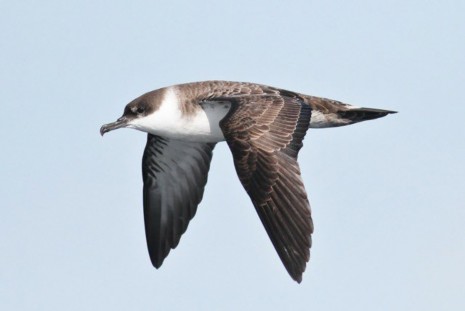
Greater Shearwater, Peaked Hill, Truro August 29, 2015.
Movement and Numbers
Why do seabirds off Provincetown generally fly into the wind? For Cory’s Shearwater or Wilson’s Storm-Petrel that are equipped with olfactory foraging capabilities, such behavior may be understandable, but it is puzzling for Parasitic Jaeger, Razorbill, and Common Tern.
I have witnessed thousands of Great Shearwaters fly east past Race Point between 6:00–7:00 am with virtually no Cory’s Shearwaters among them. An hour later, at 8:00 am, I have seen hundreds of Cory’s moving east past Race Point with no Great Shearwaters present. Is this coincidental or deliberate flocking behavior?
After watching 10,000 shearwaters fly east past Race Point and Race Point Beach, I wondered where they went, especially when I watched the same phenomenon the next day. When did all of these shearwaters fly west back into Cape Cod Bay, if at all? Are these the same birds daily?
Perhaps seabird movements are circular off Provincetown. For example, early in the morning of October 20, 2015, Kate Sutherland and I followed the movements of several hundred shearwaters that traveled east to west along the deep water rip line approximately 1,500 feet offshore from Race Point Beach toward Race Point. Once at Race Point, many of the shearwaters veered off to the north and northwest toward the southwestern corner of Stellwagen Bank. During the early afternoon, we saw several hundred shearwaters moving west to east—perhaps coming off the bank—beyond the deep water rip line. They formed several large beehives, or feeding aggregations, off to the northeast in the vicinity of the southeastern corner of Stellwagen Bank and the Peaked Hill Area. Did these shearwaters travel in a clockwise circle from the rips off Race Point to Stellwagen Bank and then off to the east this particular day? See Figure 1, for on and offshore locations around Provincetown.
The Seasons
Winter: January through March
The winter months on the ocean waters surrounding Provincetown belong to the alcids—those penguin-like black and white seabirds that can be frustratingly difficult to identify at a distance. The day-to-day directional movements of alcids, like shearwaters and other seabirds, are puzzling; and are presumably related to food resource availability, location, and perhaps wind direction and tidal currents.
All six species of North Atlantic alcids have been seen wintering off Provincetown: Razorbill, Common Murre, Thick-billed Murre, Dovekie, Black Guillemot, and Atlantic Puffin. A great winter beach day in Provincetown is to observe all six alcid species. Observers accomplished this feat twice in 2015: on January 29 from Herring Cove Beach and on February 21 from Race Point Beach.
Razorbills are the most numerous and conspicuous alcids seen off Provincetown and down the backside of Cape Cod. Modest numbers were seen during the winter months with a high count of 3,115 recorded on January 29.
Thick-billed Murres—those hunch-backed flying footballs—were seen in good numbers during the winter season and, in many cases, were observed quite close to shore. A high count of 23 from Herring Cove on January 29 and 15 reported from Race Point Beach on March 15 were notable. A couple of Thick-billed Murres in Provincetown Harbor often provided point blank photographic opportunities. Thick-billed Murres often set up shop in sheltered coves and harbors during winter.
Common Murres have been historically rare within sight of land (Veit and Petersen 1993). However, sightings from land-based vantage points over the last 10–15 years have been increasing in and around Cape Cod and certainly around Cape Ann. On February 8, 2015, observers recorded 52 Common Murres in several hours of seawatching from Race Point Beach to Race Point.
Pacific Loons were sporadic during the 2015 winter season, with individuals recorded from Provincetown and Truro.

Parasitic Jaegers Pursuing Laughing Gull, Race Point, October 15, 2015.
Spring: April through June
Spring was slow to arrive on Cape Cod (and most other places) after a brutally cold and snowy winter. However, spring eventually wrestled winter’s death grip away from the region and all hell broke loose off Provincetown on May 2, 2015. While on a late afternoon hike out to Race Point, my son Liam and I encountered an absolute blizzard of Bonaparte’s Gulls—conservatively estimated at 3,200 birds—flying in off the ocean from the northwest and landing on Race Point and just beyond in the surf line. Inconspicuously embedded within the masses of breeding plumaged (fully hooded) Bonys were several smaller, delicate, and most elegant Little Gulls, many of which also were in full breeding plumage.
Over the next couple of weeks, the number of adult Bonaparte’s Gulls decreased and immature plumaged birds moved into the region. Nevertheless, the numbers of Bonaparte’s Gulls seen in May 2015 were unprecedented; the previous high count in spring was approximately 250 birds. (Blair Nikula, personal communication). Traditionally, high counts of Bonaparte’s Gulls in Massachusetts have been recorded in late fall and early winter (Veit and Petersen 1993). At the time of this writing, May 2016, exceptional numbers of Bonaparte’s Gulls are once again being seen off Provincetown.
In addition to the Bonaparte’s Gulls, many other seabirds arrived during late April and early May 2015. Cumulative counts of Laughing Gulls, Common Terns, Roseate Terns, Herring Gulls, Great Black-backed Gulls, and several immature Iceland Gulls reached into the thousands. Curiously, substantial numbers of immature Black-legged Kittiwakes lingered off Provincetown, including 180 on June 6, 2015, and dozens summered here well into July. A Sabine’s Gull, which is an unusual spring visitor, was present at Herring Cove from May 5 through May 9.
Parasitic Jaegers, already trickling into the region, made their presence known on May 16, 2015, with 24 birds recorded from Race Point Beach. A true kleptoparasite, the Parasitic Jaeger makes a tidy living on the open sea terrorizing small gulls and terns by means of highly acrobatic, prolonged chases to force their victims to disgorge consumed fish or drop a carried fish for the jaeger to eat.
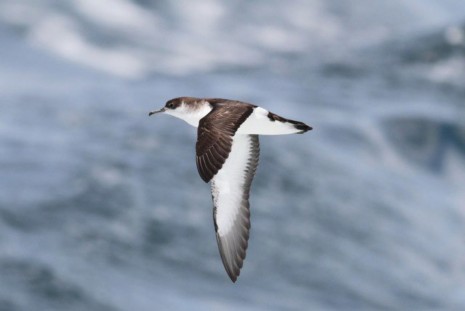
Manx Shearwater, Offshore Provincetown, June 14, 2015.
Changes to the outer beach between Race Point Beach and Race Point created a nifty little area that local birders refer to as The Cove. The Cove is a sand spit or miniature barrier beach running east to west for several hundred feet; a finger of water behind it separates the spit from the main beach area. During late spring, many gulls and terns began gathering or resting reasonably undisturbed in the Cove. This is a nice setup for an avid seabirder traversing the beach to sort through the masses of gulls and terns for a rarity.
Summer: July through September
The summer months off Cape Cod belong to the shearwaters. The four regular species off Provincetown and surrounding waters are Cory’s, Great, Sooty, and Manx shearwaters. Their mass movements off Provincetown in early mornings was quite a spectacle during July and August and well into September for 2015, as it was for 2014.
In 2015, Blair Nikula and I ran several dedicated pelagic charter trips with Captain Rich Wood aboard the seaworthy 35-foot Beth Ann out of Provincetown Harbor. These five-hour trips allowed for quick access to many of the areas where seabirds congregate, including the rips off Herring Cove, Race Point, Race Point Beach, and rarely visited (although highly productive) area northeast of Provincetown and Truro known as Peaked Hill. Additionally these trips provided access to the southeastern and southwestern corners of Stellwagen Bank to the north. To say these trips were a success would be an understatement. The photographic opportunities were excellent. Getting participants within arm’s length of Great and Cory’s shearwaters, having a jaeger chase a tern nearly into the stern of the boat, or seeing breaching humpback whales within 100 feet of the boat were seemingly routine on these trips.
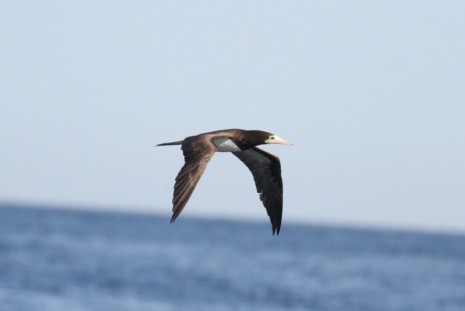
Brown Booby, Peaked Hill, Truro, August 29, 2015.
Beyond the astounding numbers and diversity of birds encountered on these dedicated pelagic trips, a couple of special rarities turned up during July and August.
On July 18, 2015, a Fea’s Petrel briefly made a pass by the Beth Ann near the Peaked Hill area off Truro delighting all onboard and providing the second state record of this spiffy North Atlantic gadfly petrel. Fea’s Petrels are seen with some regularity along the western edge of the Gulf Stream off North Carolina. They originate from the Desertas and Cape Verde Islands in the eastern North Atlantic. Curiously, the first Fea’s Petrel was recorded on June 24, 2014, on the southwest corner of Stellwagen Bank. Is this the same bird? Or is this the start of a new trend?
On August 29, 2015, a Brown Booby was seen from aboard the Beth Ann in the Peaked Hill area off Truro feeding with a mixed flock of shearwaters. This is presumably the same bird that was seen earlier in the year off Wood End and Hatches Harbor in June. Whatever is going on with Brown Boobies in the North Atlantic these days is a mystery. Historically, Brown Boobies were unknown north of Florida, but records north of Florida have increased sharply in recent years (Nisbet et al 2013). Suffice to say, I don’t think we can safely gloss over those distant brown sulids and assume they are all young Northern Gannets anymore.
Avid seabirders are always on the lookout for that rarity from some far-flung corner of the world’s oceans. So the sight of an unidentified albatross, likely a Yellow-nosed Albatross, observed on July 12, 2015, from a whalewatching boat was most intriguing. Unfortunately, the albatross was seen sitting on the water in the distance while the boat was in transit back to port. This sighting was motivational and instrumental in running as many charter trips out of Provincetown as we could with the hopes of catching up with this albatross. Fortunately, on August 10, 2015, a Yellow-nosed Albatross was observed and magnificently photographed from a whalewatching boat out of Provincetown.
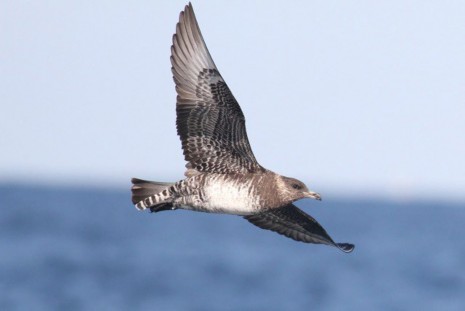
Pomarine Jaeger, Offshore Provincetown, September 6, 2015.
Sabine’s Gull is traditionally a late summer and early fall rarity off Provincetown. Two Sabine’s Gulls were reported on August 31, 2015, from Herring Cove and two were reported on September 12, 2015, from Race Point.
One of the more impressive days of the summer season was September 13, 2015. Several land-based observers spent the better part of the day seawatching from Race Point Beach and Race Point. At the same time, the New England Coastal Wildlife Alliance (NECWA) was running its traditional fall Seabirds and Whale Tails excursion to the waters off Provincetown. Suffice to say, the bases were well covered for what would be a truly extraordinary day of seabirding. A staggering 15,000 Great Shearwaters were observed from Race Point Beach and 14,350 were seen from Race Point (certainly overlap but remarkably close totals). In addition, counts from Race Point included 1,500 Cory’s Shearwaters, 12,000 unidentified Great or Cory’s shearwaters, 44 Sooty Shearwaters, and 447 Manx Shearwaters—placing the total number of shearwaters at 28,341.
The NECWA trip enjoyed a fantastic feeding frenzy of Great Shearwaters late in the afternoon approximately two miles off Race Point Beach. However, the real show was farther offshore on Stellwagen Bank earlier in the day where over 30 Pomarine Jaegers were identified and perhaps as many as 60 were observed. Many of these jaegers were seemingly traveling on a northwest to southeasterly bearing and perhaps migrating. Contrary to what I thought I knew of Pomarine Jaegers, many of these birds were successfully kleptoparasitizing Common Terns—a behavior and choice of victim that I personally had not seen before from the largest of the three jaegers. More than four Long-tailed Jaegers also showed up, including a stunning juvenile bird that chased a Common Tern right up the wake of the boat and within close distance of the stern, which allowed for great photo opportunities.
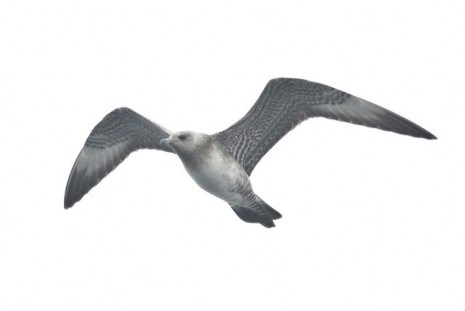
Long-tailed Jaeger, Offshore Provincetown, September 6, 2015.
Late September brought in an amazing influx of Northern Fulmars—both light and the more northerly dark phase—to the waters in and around Provincetown. Many were visible off Race Point Beach and in particular off Race Point, where some of these birds were feeding or traveling just beyond the surf line. On September 26, 2015, there were 383 and 290 Northern Fulmars recorded from Race Point and Race Point Beach respectively.
Fall: October through December
The fall season was full of highlights beginning with the nor’easter of October 2–3 that brought heavy winds and seas to the area. September’s Northern Fulmar counts were eclipsed during this storm when 950 were observed. Many of these fulmars were observed off Race Point in the surf line and slightly beyond, feeding via hen-picking at the ocean surface. What they were feeding on is a mystery. Based on reviews of many of my own photos and others, most of the birds that were part of this influx appeared quite fresh looking and were presumably young of the year.
In addition to the Northern Fulmar incursion, thousands of shearwaters and terns were recorded from observers situated at Race Point and Race Point Beach. Hundreds of jaegers of all three species were seen during the nor’easter and represented an amazing day of seawatching even for the most demanding of seabirders. However things were kicked up a notch further when a surprise visitor from the southern hemisphere—a South Polar Skua—made its presence known with an incredibly close west to east pass along the beach, providing exceptional photographic fodder.
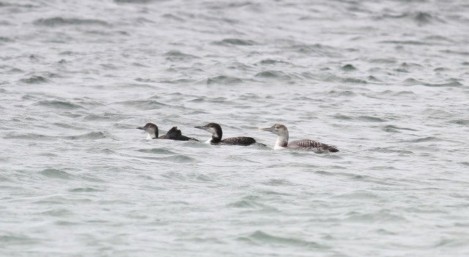
Yellow-billed Loon, Race Point, March 20, 2016.
As the fall season carried on, the question often raised among those regularly seabirding off Provincetown was: how long is this going to last? What are we to make of Parasitic Jaegers, Laughing Gulls, Sooty Shearwaters, Great Shearwaters, and Manx Shearwaters lingering into December? December 25, 2015, was the late date record for Parasitic Jaegers. In fact, it would be January 2016 before the last Great Shearwaters (January 8, 2016) and Manx Shearwaters (January 17, 2016) finally departed the area, providing late date records for Massachusetts. It was particularly interesting to see Manx Shearwaters foraging and flying alongside Razorbills during December 2015 and January 2016. It is remarkable how similar they can appear at times—an identification issue that had never really been raised until 2015.
I would be remiss in not mentioning some of the amazing sightings during the first few months of 2016. Most noteworthy was the discovery of a Yellow-billed Loon off Race Point on February 27, 2016, by Steve Arena. This bird showed well and delighted many birders for over a month; it was last reported off Race Point on April 2, 2016. In addition, three or more Pacific Loons, including one juvenile (an age class rarely if ever recorded in Massachusetts), were also present. This gave some lucky birders four species of loon on their checklists—not bad for Massachusetts.
As was the case with the Pacific Loons, two Mew Gulls of the European race (Common Gull) were discovered while birders searched for the Yellow-billed Loon. The first gull was discovered on March 13, 2016, and a second bird with notably different plumage characteristics—reduced head streaking and darker outer primaries—was recorded on March 26.
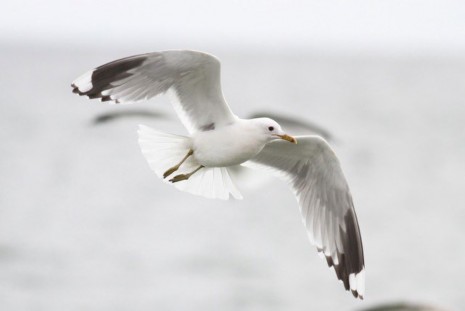
Mew Gull, Race Point, March 26, 2016.
On May 8, 2016, a White-winged Tern was discovered in a flock of resting Common Terns and Roseate Terns at Race Point. This particular flock eventually flushed off the beach and the tern was rediscovered a few hours later roosting with a jumpy flock of Common and Roseate terns at the mouth of Hatches Harbor. Unfortunately, the White-winged Tern became one of those one-day wonders. It flushed a final time from Hatches Harbor with a restless group of terns and spiraled up very high into the sky, which is a behavior often exhibited by Common and Roseate terns (Jeremy Hatch personal communication several years ago) just prior to migrating. The White-winged Tern was observed for a couple of more minutes as it continued to gain altitude and head out of Provincetown on a northeasterly bearing to its next destination.
Final Thoughts
There is inherent excitement and anticipation as one drives into the Race Point Beach parking lot during the early morning hours. Driving past several blowouts in the dune line that provide brief views of the Atlantic Ocean, it is virtually impossible to refrain from taking a peek through the sandy windows in the hopes of catching hundreds if not thousands of seabirds on the move even before pulling into a parking space and critically sorting through the masses over the water.
Table 1. Select Seabird Species High Counts off Provincetown 2015
| Species |
Number |
Date |
Location |
| Pacific Loon |
2 |
May 2, 2015 |
Herring Cove |
| Albatross sp. |
1 |
July 12, 2015 |
Stellwagen Bank |
| Yellow-nosed Albatross |
1 |
August 10, 2015 |
Stellwagen Bank |
| Northern Fulmar |
950 |
October 3, 2015 |
Race Point |
| Fea’s Petrel |
1 |
July 18, 2015 |
Stellwagen Ban SE Waters |
| Cory’s Shearwater |
8,700 |
August 9, 2015 |
Race Point Beach |
| Great Shearwater |
15,000 |
September 13, 2015 |
Race Point Beach |
| Sooty Shearwater |
1100 |
June 29, 2015 |
Race Point Beach |
| Manx Shearwater |
447 |
September 13, 2015 |
Race Point |
| Shearwater sp. |
5,000 |
September 21, 2015 |
Race Point Beach |
| Wilson’s Storm-Petrel |
1,000 |
July 20, 2015 |
Stellwagen Bank |
| Leach’s Storm-Petrel |
5 |
October 5, 2015 |
Race Point |
| Brown Booby |
1 |
August 29, 2015 |
Peaked Hill |
| Northern Gannet |
12,640 |
November 11, 2015 |
Race Point |
| Red Phalarope |
1 |
November 4, 2015 |
Stellwagen Bank |
| Red-necked Phalarope |
51 |
August 19, 2015 |
Stellwagen Ban SE Waters |
| Sabine’s Gull |
2 |
September 12, 2015 |
Race Point |
| Black-legged Kittiwake |
1,200 |
December 19, 2015 |
Race Point Beach |
| Little Gull |
10 |
May 6, 2015 |
Herring Cove Beach |
| Bonaparte’s Gull |
3,200 |
May 2, 2015 |
Race Point |
| Black-headed Gull |
3 |
September 23, 2015 |
Race Point Beach |
| Laughing Gull |
900 |
September 13, 2015 |
Race Point |
| Iceland Gull |
42 |
December 31, 2015 |
Race Point |
| Lesser Black-backed Gull |
87 |
May 16, 2015 |
Race Point |
| Caspian Tern |
2 |
September 21, 2015 |
Race Point Beach |
| Royal Tern |
4 |
July 4, 2015 |
Race Point Beach |
| Common Tern |
7,200 |
September 13, 2015 |
Race Point |
| Arctic Tern |
5 |
June 7, 2015 |
Race Point Beach |
| Roseate Tern |
600 |
September 20, 2015 |
Race Point |
| Black Tern |
25 |
September 3, 2015 |
Herring Cove |
| Long-tailed Jaeger |
4 |
September 6, 2015 |
Race Point Waters |
| Parasitic Jaeger |
125 |
October 3, 2015 |
Herring Cove |
| Pomarine Jaeger |
38 |
September 26, 2015 |
Race Point |
| South Polar Skua |
1 |
October 3, 2015 |
Race Point |
| Black Guillemot |
6 |
February 1, 2015 |
Race Point Beach |
| Common Murre |
52 |
February 8, 2015 |
Race Point Beach |
| Thick-billed Murre |
23 |
January 29, 2015 |
Herring Cove |
| Razorbill |
3,115 |
January 29, 2015 |
Herring Cove |
| Dovekie |
37 |
November 21, 2015 |
Race Point Beach |
| Atlantic Puffin |
3 |
October 24, 2015 |
Off Provincetown |
For some people, the seabirding experience is setting up a spotting scope in the dune line and observing the show from a distance. For others, it is a walk down to the waterline for a closer look. Or it is a half or full day hike out to Race Point to the west. More recently, folks such as Steve Arena have been seabirding by using an off road vehicle (ORV), which provides quick and easy access from Hatches Harbor to Race Point Beach and points south. For summer seabirding, Blair Nikula and I began chartering the 35–foot boat Beth Ann out of Provincetown Harbor in 2015 to get in and among the masses of seabirds and gain a better understanding and appreciation of seabird movements and behavior throughout the day.
However you prefer to look at seabirds, I encourage birders who list their seabird sightings in and around Provincetown to take note of factors and variables such as wind speed and direction, tidal state, sea conditions, flight direction of seabirds, and feeding aggregations. These data will help us learn more about the seabirds that frequent our waters.
As previously noted, I have far more questions than answers and I’m not sure I feel any wiser for my efforts—but I sure am having fun trying. Hope to see you on the beach or offshore in 2016.
Acknowledgements
First and foremost, I would like to thank Blair Nikula for many years of field companionship on land and sea, and many thoughtful and at times lively discussions of seabirds. Blair and Kate Sutherland provided many helpful edits, suggestions, comments, additions, and subtractions to a draft of this article. I also would like to acknowledge Steve Arena, who has been a force and a fixture at Race Point and continues to compile some amazing sightings. He expands our knowledge of the movements and behaviors of seabirds off Provincetown with his dedication, perseverance, and enthusiasm. Last, I would like to acknowledge Captain Rich Wood of the Beth Ann for providing access at sea to many of the offshore areas of Provincetown and Truro, and the participants who registered for these pelagic excursions, as these trips would not be possible otherwise.
References
- Howell, S. N. G. 2012. Petrels, Albatrosses and Storm-Petrels of North America. Princeton: Princeton University Press.
- Nisbet, I. C. T., R. R. Veit, S. A. Auer, and T. P. White. 2013. Marine Birds of the Eastern United States and the Bay of Fundy. Nuttall Ornithological Monographs, No. 29, Cambridge, Massachusetts: Nuttall Ornithological Club.
- Veit, R. R. and W. R. Petersen. 1993. Birds of Massachusetts. Lincoln: Massachusetts Audubon Society.
- Warham, J. 1996. The Behavior, Population Biology, and Physiology of the Petrels. London: Academic Press.
Peter Flood, a Cape Cod resident, has a passion for ornithology. His birding interests are primarily focused on the ecology of seabirds. He has been a naturalist for Mass Audubon’s Wellfleet Bay Wildlife Sanctuary leading birding tours and educational programs related to bird identification, natural history and biology; conducted Mass Audubon’s aerial seabird and waterfowl surveys of Nantucket Sound as part of the proposed “Cape Wind” project; and conducted shorebird surveys for Manomet Center for Conservation Sciences. Peter also volunteers with NOAA, conducting seabird surveys of the Stellwagen Bank National Marine Sanctuary. Peter serves as Secretary on the Board of Directors for the Cape Cod Bird Club. His current profession is a Senior Project Manager with Green Seal Environmental, Inc.